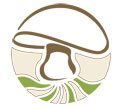Marlborough Deeps
Sun 21 Jul 2024
Field event ID HF2405
OS Grid areas: SZ2298 SZ2299
Report: This was a well-chosen site for an early season visit as the woodland is damp even during the summer months.
On our walk from the car park across the lawn, we discovered the minute Pilobolus crystallinus (Dung Cannon) on pony dung. This species consists of a 2mm transparent stem topped by a black spore capsule. The stem is water-filled and sunlight triggers it to expand until the pressure built up, forcibly ejects the spore capsule at speeds of up to 60mph and to a distance of several metres. A sticky substance in the capsule allows some spores to attach to nearby grasses where it can then be eaten by passing herbivores. In order to germinate it needs to pass through the gut of an herbivore and this dispersal mechanism ensures that the spores are projected away from the unpalatable dung heaps. Some of the dung also bore the tiny orange eyelash discs of Cheilymenia stercorea.
Once in the wood, we soon found Auriscalpium vulgare (Ear Pick Fungus), the little Marasmius hudsonii (Holly Parachute) on dead Holly leaves and the equally tiny, Gymnopus quercophilus (Oak Toughshank).
On a grassy ride we found a curious Epichloë species (Choke), a gall-like fungus that grows on grass stems. It forms a tubular constriction which inhibits the flowering of the grass. It is about 1cm long and matures from white to bright yellow.
Deeper into the wood we came across a group of impressive Ramaria (Coral) fungi which were thought to be R. pallida. Other species noted were Russula caerulea (Humpback Brittlegill), Amanita excelsa var. spissa (Grey Spotted Amanita), Amanita gemmata (Jewelled Amanita) and Neoboletus luridiformis (Scarletina Bolete).
Species recorded: Amanita excelsa var. spissa (Grey Spotted Amanita), Amanita fulva (Tawny Grisette), Amanita junquillea (Jewelled Amanita), Amanita rubescens, Asterostroma laxum (Loose Starweb), Auriscalpium vulgare (Earpick Fungus), Boletus edulis (Cep), Boletus luridiformis, Calocera cornea (Small Stagshorn), Calocera pallidospathulata (Pale Stagshorn), Calocera viscosa (Yellow Stagshorn), Cantharellus cibarius (Chanterelle), Cheilymenia stercorea, Coprinopsis cordispora (Ticker Inkcap), Crepidotus cesatii (Roundspored Oysterling), Dacrymyces stillatus (Common Jelly Spot), Daedaleopsis confragosa (Blushing Bracket), Daldinia concentrica (King Alfred's Cakes), Datronia mollis (Common Mazegill), Delicatula integrella, Epichloe baconii, Fomitopsis betulina (Birch Polypore), Gymnopus erythropus (Redleg Toughshank), Gymnopus fusipes (Spindle Toughshank), Gymnopus quercophilus (Oak Toughshank), Heterobasidion annosum (Root Rot), Hyphoderma argillaceum, Hyphoderma transiens, Laccaria laccata (Deceiver), Lactarius tabidus (Birch Milkcap), Laetiporus sulphureus (Chicken Of The Woods), Mycena corynephora, Mycena sanguinolenta (Bleeding Bonnet), Panaeolus semiovatus, Phacidium lauri, Phellinopsis conchata, Phellinus igniarius (Willow Bracket), Pilobolus kleinii, Pluteus cervinus (Deer Shield), Polyporus tuberaster (Tuberous Polypore), Psathyrella candolleana (Pale Brittlestem), Pseudosperma perlatum, Russula betularum (Birch Brittlegill), Russula caerulea (Humpback Brittlegill), Russula fragilis, Russula risigallina (Golden Brittlegill), Russula vesca (The Flirt), Schizopora paradoxa (Split Porecrust), Schizopora radula, Scutellinia scutellata (Common Eyelash), Sidera vulgaris, Skeletocutis semipileata (Hazel Bracket), Steccherinum ochraceum, Stereum hirsutum (Hairy Curtain Crust), Stereum subtomentosum (Yellowing Curtain Crust), Trochila ilicina (Holly Speckle)
A full species list with further details can be seen at the Fungal Records Database of Britain and Ireland (FRDBI). Please contact us if you need a user ID.









